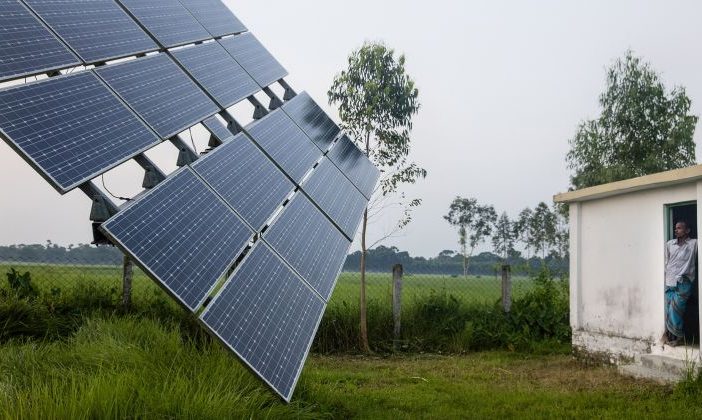- The electrification of rural communities remains a challenge for central grids, as communities tend to be spread across vast swathes of land.
- Minigrids, especially those powered by PV, are much better equipped to serve such places, according to the new “State of the Global Mini-grids Market Report 2020,” recently published by BloombergNEF and Sustainable Energy for All.
The authors of the report counted 7,181 minigrid projects as of March 2020 throughout Sub-Saharan Africa, Asia, and a number of small island nations, in addition to some installations in Latin America. Nearly 5,545 of those projects are operational, and around 63% of them are powered by solar, or they are solar hybrids. Asia appears to be the hottest market, accounting for about 60% of all completed projects. Another 39% are found across Sub-Saharan Africa, with Latin America and small island nations accounting for the remainder.
Attractive economics
The researchers said solar and solar hybrid minigrids offer the most attractive economics for the electrification of rural communities, even compared with diesel generators or centralized grid connections. Most electrical appliances are supposed to be run during the day, so irradiation hours coincide with load profiles for the most part.
If that is not possible, a growing number of solar minigrids also feature battery storage. Lead-acid batteries have been the preferred option in the past, based on their technological readiness and comparatively low costs. However, lithium-ion technologies have caught up in recent years, as prices for the technology have come down.
Other generating methods, such as hydropower stations or diesel and heavy fuel oil generators, account for just 21% and 11% of all minigrid projects, respectively. Solar will likely maintain its lead in this application in the future.
Looking at the data from various associations and monitoring bodies, the report’s authors found that the solar minigrid market has expanded from 60 installed solar-backed grids in 2010 to an installed base of 2,099 by February of this year.
Cost and demand
Costs are an issue with minigrids, as customers often lack purchasing power. And due to a lack of high-load appliances, very little energy is typically consumed. The resulting levelized cost of energy thus ranges from $0.49/kWh to $0.68/kWh for solar hybrid minigrids serving customers in isolated areas.
Minigrid business models can be aligned with the commercial activities of beneficiary communities, and a range of productive use loads can be set up, to address the issues of cost and demand. Reportedly, the most common productive-use cases are light manufacturing, agro-processing, illumination, and service provision.
In 2010, when the Sustainable Development Goals were adopted, 1.4 billion people throughout the world lacked electricity access. Today, that number is down to 789 million, according to the SDG 7 tracking report. The achievement had been realized by grid extensions and the rollout of offgrid solar kits.
However, in Sub-Saharan Africa alone, 600 million people still lack electricity access. Given the current pace of electrification and population growth across the region, the researchers believe that 620 million people will be without electricity within a decade.
“In the fallout of Covid-19, countries have a unique opportunity to ‘recover better’ and reset their economies while accelerating energy access,” said Damilola Ogunbiyi, CEO of Sustainable Energy for All. “Now, more than ever, we need a thriving mini-grids sector that can power critical infrastructure and give access to the 789 million people worldwide who lack electricity. We must improve regulatory frameworks, commit greater finance and scale innovative minigrid business models. This research offers critical insights for all minigrids stakeholders that can help the market reach its full potential and deliver Sustainable Development Goal 7 progress.”
New approaches
The lion’s share of electrification has reportedly been done via main grid extensions, but the areas in which such an approach is economically and technically feasible have already been exhausted. Now, the researchers are urging governments and utilities to pursue a least-cost-approach, under which they deploy solar minigrids as cheaper alternatives.
Doing so could connect 111 million households across Sub-Saharan Africa by 2030. That would be nearly half of the 238 million households that still need electricity throughout the region. The potential costs have been estimated at $128 billion.
The business-as-usual scenario, with 620 million people still lacking access by the end of the decade, would cost $72 billion. Grid extensions and solar home systems could reach people for whom minigrids are not the least-cost option. Rolling out the three technologies to connect all 238 million households would translate into $243 billion of investment.
The space was initially the domain of small startups, but today, international power companies have swept in. EDF, Enel, Engie, Iberdrola, Shell and Tokyo Electric Power Co. are reportedly among this group of investors. Such companies seek to minimize investment risks by placing the burden on governments to enable a business environment in which minigrid investments are safe. In Nigeria, there are regulations that compensate minigrid owners if the main grid reaches a community after a minigrid system has already been built.
The researchers identified a need for streamlined regulations, clear subsidies, licensing procedures, and tariff-setting policies.
“As the market matures, funding deployment must be quicker,” said Takehiro Kawahara, frontier power lead analyst at BloombergNEF. “This is linked to the policy and regulations of the countries where recipients of funding are located. Governments need to promote robust regulatory frameworks that support the development of minigrids.”
Author: Marian Willuhn
This article was originally published in pv magazine and is republished with permission.















